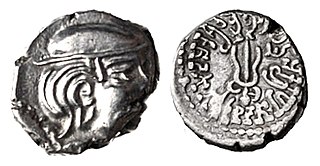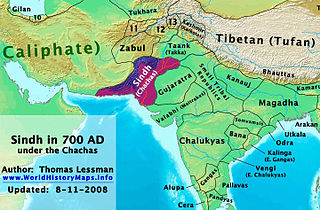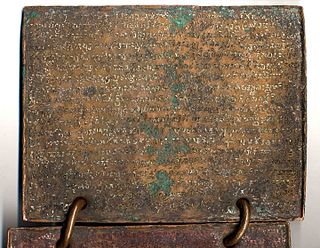Related Research Articles

The Pratihara dynasty, also called the Gurjara-Pratiharas, the Pratiharas of Kannauj or the Imperial Pratiharas, was a prominent medieval Indian dynasty which ruled over the Kingdom of Kannauj. It initially ruled the Gurjaradesa until its victory in the Tripartite Struggle in 816 which secured its right to the throne of Kannauj. Cadet branches of the dynasty ruled other minor states in the subcontinent.

The Maitraka dynasty ruled the Kingdom of Valabhi in western India from approximately 475 to 776 from their capital at Vallabhi. With the sole exception of Dharapaṭṭa, who is associated with sun-worship, they were followers of Shaivism. Their origin is uncertain but they were probably Chandravanshi Kshatriyas.
Vallabhi is an ancient city located in the Saurashtra peninsula of Gujarat, near Bhavnagar in western India. It is also known as Vallabhipura and was the capital of the Kingdom of Valabhi, an early medieval state ruled by the Chandravanshi Maitraka Dynasty.
Pulakeshi II popularly known as Immaḍi Pulakeśi, was the greatest Chalukyan Emperor who reigned from Vatapi. During his reign, the Chalukya empire expanded to cover most of the Deccan region in peninsular India.

Bhinmal is an ancient town in the Jalore District of Rajasthan, India. It is 72 kilometres (45 mi) south of Jalore. Bhinmal was the early capital of Gurjaradesa, comprising modern-day southern Rajasthan and northern Gujarat. The town was the birthplace of the Sanskrit poet Magha and mathematician-astronomer Brahmagupta.

The Umayyad Dynasty came to rule the Caliphate in 661 CE, and during the first half of the 8th century CE, a series of battles took place in the Indian subcontinent between armies of the Umayyad Caliphate and Indian kingdoms situated to the east of the Indus river, subsequent to the Arab conquest of Sindh during 711 – 713 CE.
The Malavas or Malwas were an ancient Indian tribe. They are believed to have lived in the Punjab region at the time of Alexander's invasion in the 4th century BCE. Later, the Malavas migrated southwards to present-day Rajasthan, and ultimately to Madhya Pradesh and Gujarat. Their power gradually declined as a result of defeats against the Western Satraps, the Gupta emperor Samudragupta, and the Chalukya emperor Pulakeshin II.

Shiladitya is the title of a 7th-century Indian king mentioned in the writings of the Chinese traveler Xuanzang.
The Gurjaras of Lata, also known as Gurjaras of Nandipuri or Bharuch Gurjaras, was a dynasty which ruled Lata region as a feudatory of different dynasties from c. 580 CE to c. 738 CE.
Valabhi University was an important centre of Buddhist learning and championed the cause of Hinayana Buddhism between 600 CE and 1400 CE. Valabhi was the capital of the Maitraka empire during the period 480-775 CE. It was an important port for international trade located in Saurashtra, present-day it is called Valabhi located in Bhavnagar district of Gujarat in western India, identical with the old state of Vala. Yijing, a Chinese traveler had observed that the education given at Valabhi was comparable to the education provided at Nalanda, in Bihar, in the field of education. In September 2017, the Indian central government started to consider a proposal to revive the ancient university. A proposal, under the umbrella of an organisation called Sanghkaya, was sent to the central government, which the Union ministry of culture has agreed.

Udayin also known as Udayabhadra was a king of Magadha in ancient India. According to the Buddhist and Jain accounts, he was the son and successor of the Haryanka king Ajatashatru. Udayin laid the foundation of the city of Pataliputra at the confluence of two rivers, the Son and the Ganges. He shifted his capital from Rajagriha to Pataliputra due to the latter's central location in the empire.
Gurjaradesa, is a historical region in India comprising the southern Rajasthan and northern Gujarat during the period of 6th–12th century CE. The predominant power of the region, the Gurjara-Pratiharas eventually controlled a major part of North India centered at Kannauj. The modern state of "Gujarat" derives its name from the ancient Gurjaratra.
The origin of the Gurjara-Pratihara dynasty of India is a topic of debate among historians. The rulers of this dynasty used the self-designation "Pratihara" for their clan, but have been described as "Gurjara" by their neighbouring kingdoms. Only one particular inscription of a feudatory ruler named Mathanadeva mentions him as a "Gurjara-Pratihara".
The Guhilas of Medapata colloquially known as Guhilas of Mewar were a Rajput dynasty that ruled the Kingdom of Mewar region in present-day Rajasthan state of India. The Guhila kings initially ruled as Gurjara-Pratihara feudatories between the end of 8th and 9th centuries and later were independent in period of the early 10th century and allied themselves with the Rashtrakutas. Their capitals included Nagahrada (Nagda) and Aghata (Ahar). For this reason, they are also known as the Nagda-Ahar branch of the Guhilas.

The Kalachuris of Mahismati, or the Early Kalachuris, were an early medieval Indian dynasty that ruled present-day Maharashtra, as well as parts of mainland Gujarat and southern Madhya Pradesh. Their capital was located at Mahishmati. Epigraphic and numismatic evidence suggests that the earliest of the Ellora and Elephanta cave monuments were built during the Kalachuri rule.

The Gupta era is a historical calendar era that begins from c. 318–319 CE. It was used by the Gupta emperors, as well as their vassals and their successors in present-day northern India and Nepal. It is identical to the Vallabhi era, which was used in the Saurashtra region of western India, although regional differences lead to a slightly different calculation for the conversion of Vallabhi era years to Common Era (CE).

The Saindhavas, also known as Jayadrathas, was a medieval Indian dynasty that ruled western Saurashtra from c. 735 CE to c. 920 CE, probably in alliance with Maitrakas in its early years. Their capital was at Bhutamabilika. The known historical events during their rule are the attacks of Arabs repulsed by Agguka I.
Govindagupta was a Gupta prince of ancient India. He was a son of Chandragupta II and Dhruvadevi, and a brother of Kumaragupta.
Shiladitya may refer to:

The Kingdom of Valabhi was an early medieval kingdom in Western India from 475 to 776. It was founded by Bhatarka, a warlord in the Magadhan Empire, and ruled by the Maitraka dynasty.
References
- 1 2 3 David P. Henige (1975). "Some Phantom Dynasties of Early and Medieval India: Epigraphic Evidence and the Abhorrence of a Vacuum". Bulletin of the School of Oriental and African Studies, University of London. 38 (3). Cambridge University Press / School of Oriental and African Studies: 542. JSTOR 613706.
- ↑ Umakant Premanand Shah (1960). Sculptures from Śāmalājī and Rodā (North Gujarat) in the Baroda Museum. V.L. Devkar. p. 4.
- 1 2 Gautam N. Dwivedi (1971). "Credibility of Yuan Chwang". Proceedings of the Indian History Congress. 33. Indian History Congress: 43. JSTOR 44145304.
- 1 2 3 4 5 S. V. Sohoni (1985). "A historical approach to Bāṇa's Kādambarī". Annals of the Bhandarkar Oriental Research Institute. 66 (1/4). Bhandarkar Oriental Research Institute: 207–209. JSTOR 41693606.
- 1 2 Surendra Nath Sen (1979). India Through Chinese Eyes. K.P. Bagchi. pp. 174–175. OCLC 7531035.
- ↑ M. S. Moray (1985). History of Buddhism in Gujarāt. Saraswati Pustak Bhandar. p. 44.
- 1 2 Rama Shankar Tripathi (1989). History of Kanauj. Motilal Banarsidass. pp. 108–109. ISBN 9788120804784.
- ↑ Bindeshwari Prasad Sinha (1977). Dynastic History of Magadha. Abhinav. pp. 100–101. ISBN 9780883868218.
- ↑ Radha Kumud Mookerji (1999) [1965]. Harsha. Motilal Banarsidass. p. 12. ISBN 9788120808621.